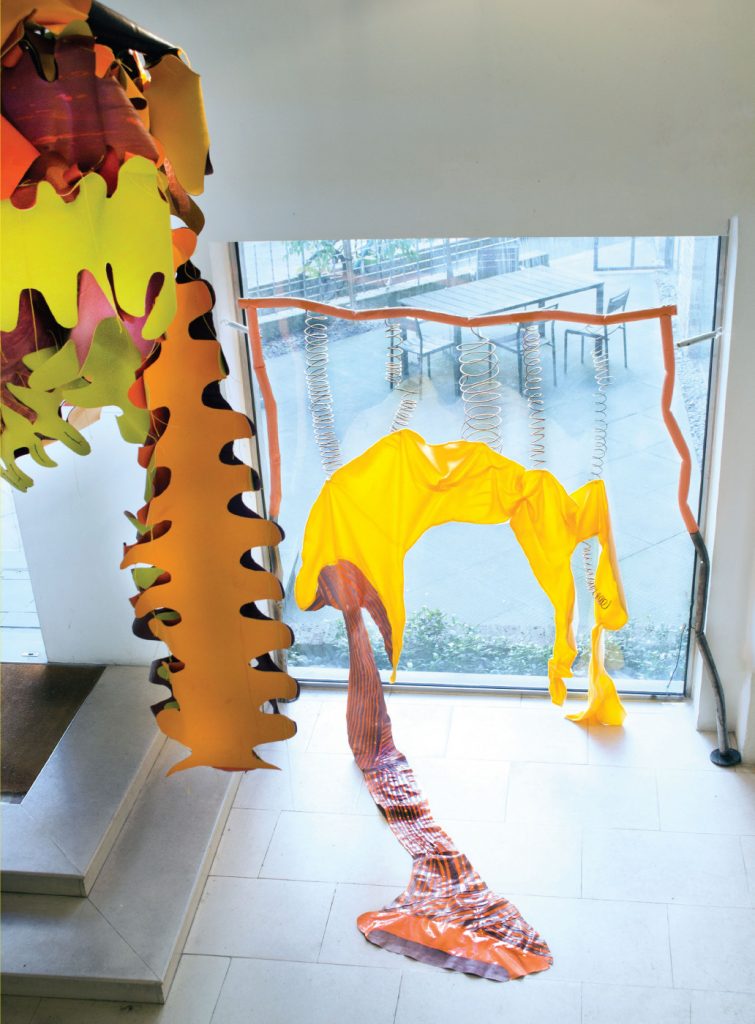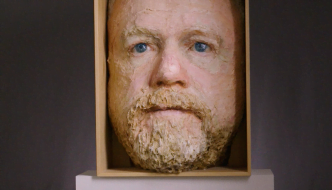The creative workspace of London’s THECUBE has become a site for experimentation for selected MA Art & Science students at Central St Martins (CSM). Beyond the Brain presents a number of works exploring Andy Clark and David Chalmer’s ‘Extended Mind Theory’ – a seminal piece of academia examining the active role of the environment on our cognitive processes. The exhibition is spread over two floors, containing a range of media, from sculpture to installation, painting and photo collage.
The CSM MA is a two-year course, investigating the creative relationship between art and science through artistic practice. Beyond the Brain was developed by six students selected for a six-month residency at THECUBE, a co-working space between freelancers and small businesses dedicated to science, technology and design.

Priya Odedra – Arborometer (2018)
Upon arriving to the exhibition, visitors are met with the large organic sewn sculptures of Sabrina Mumtaz Hasan. In the development of her own term “socio-parasitology”, Hasan has built a model that explores how human interaction can be compared to parasitic behavioural traits, which she represents through a manifesto, sculpture and painting.
A common concept explored within the exhibition is our relationship with technology. A visually strong response to this is Tracey Zhang’s Embodied Series (2018), consisting of 16 small sculptures symbolising a brain circuit, based on the square shapes of QR codes and cerebral neural aesthetics. Motifs of QR aesthetic are repeated throughout her work, and appear on the head of an emaciated torso.
Charlotte Bolster’s Work of Desire (2018) investigates the impact of the internet on our sense of identity, which she presents through the manipulation of online stock images. By adopting the aesthetic of the cracked surface of a mirror, she questions the impact of these images in real life and the way that we relate to each other.
Priya Odedra’s interactive work, Aborometer (2018), analyses our relationship with technology as a way of enhancing our emotional connection to the environment. The Aborometer is a geometric structure that invites visitors to place their hands on a sensor, causing the artwork to spring to life, and respond to the participant’s heart rate and galvanic skin-response.

Sabrina Mumtaz Hasan – You need to Interrupt so you are Parasitic (2018)
In Sensing Mind (2018), Becky Lyon extends this investigation between the self and the environment, by posing the question of nature existing as an extension of our mind. Through screen printing and sculpture, Lyon juxtaposes intricate forms and materials exploring imagined landscapes. How much of what we experience is mediated in the mind?
The final residency artist, Jasmine Smith, presents an interesting exploration into the neurology of dance. Smith is concerned with the synaptic connections that are formed in the brain when we learn and memorise new information. In The Changing Brain (2018), she has produced paintings and collages that represent synaptic plasticity occurring as dancers learn a new routine.
Where some might judge this exhibition upon its setting within an office space, it’s important to emphasise that its strength lies in its adaptability. In conversation with Lyon, she explained how the exhibition is treated as an open process, where the artists are able to test different ways of hanging and laying out their work. This freedom could not be more suited to MA students seeking to develop the concept and presentation of their work.
Beyond the Brain re-interprets complex themes in neuroscience through an accessible and creative display of artwork, fulfilling the mission of THECUBE to explore the potential for neuroscience to move beyond academia.
‘Beyond the Brain’ is on at THECUBE until September (Mon – Fri, 10am – 5pm)
Filed under: Art & Photography, Film, TV & Tech
Tagged with: art, brain, exhibition, Science, technology



Comments